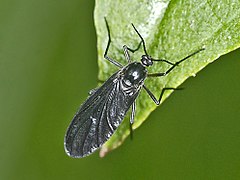Sciara (fly)
| Sciara | |
|---|---|

| |
| Sciara species | |
| Scientific classification | |
| Kingdom: | Animalia |
| Phylum: | Arthropoda |
| Class: | Insecta |
| Order: | Diptera |
| Family: | Sciaridae |
| Genus: | Sciara Meigen, 1803 |
| Synonyms[1] | |
Sciara is a genus of fungus gnats in the family Sciaridae.[2]
Species[]


Sciara is among the largest genus in the world, with over 700 species. Species within this genus include:[3][4]
Description[]
The adult fly is small, up to 3 mm, has a dark brown body, small head and its legs and wings are comparatively long, looking like a mosquito.
Biology[]
These insects feed on decaying organic matter and fungi. They are often found in greenhouses. Their larvae are up to 6 mm long, white, slender and legless, with a black head and smooth semi-transparent skin which reveals the contents of the digestive tract.
Sex determination in Sciara is a different mechanism. Sciara basically has 4 pairs of chromosomes 3 pairs of autosomes and one pair of allosomes. Some special chromosomes called limited chromosomes are present in certain stages. The zygote has 3 pairs of autosomes a one or more limited chromosomes and 3 X chromosome (2 fathers’, 1 mother's). There are 2 stages in Sciara: the Germ line and the Somaline.[5][6]
Germ line[]
The Germ line is the gametic line where the gamete formation takes place. The number of chromosomes during this line is different in males and females.
In the formation sperms of males the 1st spermatocystic division is monocentric mitosis, the maternal and paternal homologous chromosomes are separated. Then few limited chromosomes are eliminated not all of them. After this one paternal X chromosome is also eliminated. Hence male germ line (spermatogonia) cells have 3 pairs of autosomes, 2 (one maternal and one paternal) X chromosomes and a few limited chromosomes.
In the formation ova of the females the 1st ovarian division is monocentric mitosis, the maternal and paternal homologous chromosomes are separated. Then few limited chromosomes are eliminated not all of them. After this both 2 paternal X chromosome are also eliminated. Hence female germ line (oogonia) cells have 3 pairs of autosomes, 1 maternal X chromosomes and a few limited chromosomes.
Soma line[]
Soma line is the vegetative stage. During early cleavage stages of the embryo limited chromosomes are eliminated. The number of chromosomes during this line is different in males and females.
In males during the 5th and 6th divisions of the embryo all the limited chromosomes are eliminated. Then paternal X chromosome is eliminated which are 2 in number. Hence male soma line cells have 3 pairs of autosomes and one maternal X chromosome.
In the females during the 5th and 6th divisions of the embryo all the limited chromosomes are eliminated. In the next stage of cleavage one paternal X chromosome is eliminated. Hence female soma line cells have 3 pairs of autosomes and one maternal and one paternal X chromosome.
Bibliography[]
- Pettey, F. W., 1918. A revision of the genus Sciara of the family Mycetophilidae (Diptera). Ann. Ent. Soc. America, vol. 11 no. 4.
- Ruiz MF et al. - An Unusual Role for doublesex in Sex Determination in the Dipteran Sciara- Genetics. (2015)
- Vilkamaa P et al - The genus Sciara Meigen (Diptera, Sciaridae) in New Caledonia, with the description of two new species - Zootaxa. (2015)
References[]
| Wikispecies has information related to Sciara (fly). |
| Wikimedia Commons has media related to Sciara. |
- ^ Fauna eureopaea
- ^ BioLib
- ^ Catalogue of life
- ^ Heller, K., Vilkamaa, P. & Hippa, H. 2009 - An annotated check list of Swedish black fungus gnats (Diptera, Sciaridae). Sahlbergia Vol. 15(1): 23-51.
- ^ Unique Biological Features of Sciara in Sciara Stock Center
- ^ Sciara Genome in Sciara Stock Center
- Sciaridae
- Taxa named by Johann Wilhelm Meigen
- Sciaroidea genera